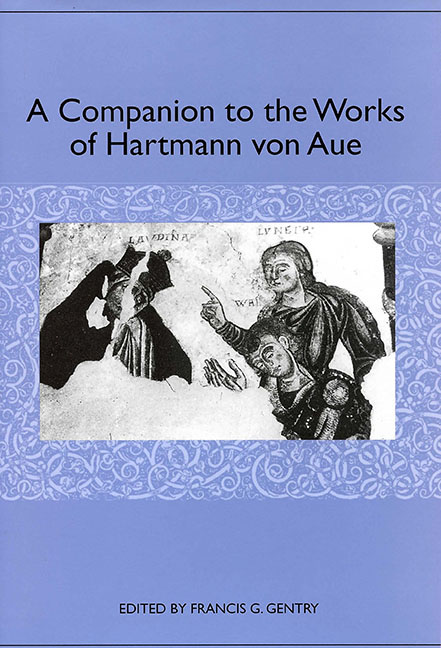Book contents
- Frontmatter
- Contents
- Acknowledgments
- Introduction
- Hartmann's Theological Milieu
- Hartmann von Aue as Lyricist
- Hartmann von Aue and Chrétien de Troyes: Respective Approaches to the Matter of Britain
- Gender and Love in the Epic Romances of Hartmann von Aue
- The Two-Fold Path: Erec and Enite on the Road to Wisdom
- The Body in Pain in the Works of Hartmann von Aue
- Illness and Cure in Hartmann von Aue's Arme Heinrich and Iwein
- Hartmann's Legends and the Bible
- Hartmann's Works in the Visual Arts
- The Medieval Literary Reception of Hartmann's Works
- A Tale of Sacrifice and Love: Literary Way Stations of the Arme Heinrich from the Brothers Grimm to Tankred Dorst
- Editions and Translations of Hartmann's Works
- Works Cited
- Notes on the Contributors
- Index
A Tale of Sacrifice and Love: Literary Way Stations of the Arme Heinrich from the Brothers Grimm to Tankred Dorst
Published online by Cambridge University Press: 27 April 2017
- Frontmatter
- Contents
- Acknowledgments
- Introduction
- Hartmann's Theological Milieu
- Hartmann von Aue as Lyricist
- Hartmann von Aue and Chrétien de Troyes: Respective Approaches to the Matter of Britain
- Gender and Love in the Epic Romances of Hartmann von Aue
- The Two-Fold Path: Erec and Enite on the Road to Wisdom
- The Body in Pain in the Works of Hartmann von Aue
- Illness and Cure in Hartmann von Aue's Arme Heinrich and Iwein
- Hartmann's Legends and the Bible
- Hartmann's Works in the Visual Arts
- The Medieval Literary Reception of Hartmann's Works
- A Tale of Sacrifice and Love: Literary Way Stations of the Arme Heinrich from the Brothers Grimm to Tankred Dorst
- Editions and Translations of Hartmann's Works
- Works Cited
- Notes on the Contributors
- Index
Summary
The master in Weimar was “not amused.” Hartmann von Aue's verse tale Der Arme Heinrich, in the poor translation of Johann Gustav Büsching, was “in and of itself a quite admirable lyrical work,” yet it evoked in Goethe, nonetheless “physical and aesthetic distress.” He noted the following unpleasant impressions in his Tag- und Jahreshefte of 1811:
Den Ekel gegen einen aussätzigen Herrn, für den sich das wackerste Mädchen aufopfert, wird man schwerlich los; wie denn durchaus ein Jahrhundert, wo die widerwärtigste Krankheit in einem fort Motive zu leidenschaftlichen Liebes- und Rittertaten reichen muß, uns mit Abscheu erfüllt. Die dort einem Heroismus zum Grunde liegende schreckliche Krankheit wirkt wenigstens auf mich so gewaltsam, daß ich mich vom bloßen Berühren eines solchen Buches schon angesteckt glaube. (511)
Although Wilhelm Wackernagel defended Hartmann against this “grundlose Behauptung” and, in fact, praised him for his delicacy in dealing with the topic (Stadler, 237–38), the unappetizing connotations of leprosy (miselsuht, Arme Heinrich, 119), the alleged description of which so repelled Goethe would not become acceptable to modern tastes until a greater medical significance was allotted to the disease and its treatment. This, then, would be capable of suppressing not only the offensiveness of the medical diagnosis but also the ethically and aesthetically problematic cure. Credit for initiating this change in approach belongs to the Grimms, who paved the way for a broad reception of the work with their 1815 edition of the Arme Heinrich, which aimed at a popular as well as creative reception. This is all the more astonishing since the sparse and relatively late manuscript transmission — however questionable this might be as a criterion — seems to make obvious that this short tale in verse was by no means as admired or widespread as his other courtly works or those of his contemporaries. It could also be that the proponents of literature around 1200 did not know how to deal with a work that was more concerned with rejection of the world than with the vigorous affirmation of chivalric joy and its importance in earthly life. Similarly, during the late Middle Ages, when it was a matter of adapting the great verse epics of the courtly period to the tastes of a new listening and — increasingly — reading public, a tale of divine affliction, religious redemption and rebirth, and — finally — grace might well have found no real resonance.
- Type
- Chapter
- Information
- A Companion to the Works of Hartmann von Aue , pp. 223 - 254Publisher: Boydell & BrewerPrint publication year: 2004

